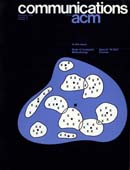November 1975 - Vol. 18 No. 11

Features
A vector space model for automatic indexing
In a document retrieval, or other pattern matching environment where stored entities (documents) are compared with each other or with incoming patterns (search requests), it appears that the best indexing (property) space is one where each entity lies as far away from the others as possible; in these circumstances the value of an indexing system may be expressible as a function of the density of the object space; in particular, retrieval performance may correlate inversely with space density. An approach based on space density computations is used to choose an optimum indexing vocabulary for a collection of documents. Typical evaluation results are shown, demonstating the usefulness of the model.
Specifying queries as relational expressions: the SQUARE data sublanguage
This paper presents a data sublanguage called SQUARE, intended for use in ad hoc, interactive problem solving by non-computer specialists. SQUARE is based on the relational model of data, and is shown to be relationally complete; however, it avoids the quantifiers and bound variables required by languages based on the relational calculus. Facilities for query, insertion, deletion, and update on tabular data bases are described. A syntax is given, and suggestions are made for alternative syntaxes, including a syntax based on English key words for users with limited mathematical background.
A genealogy of control structures
The issue of program control structures has had a history of heated controversy. To put this issue on a solid footing, this paper reviews numerous theoretical results on control structures and explores their practical implications.
The classic result of Böhm and Jacopini on the theoretical completeness of if-then-else and while-do is discussed. Several recent ideas on control structures are then explored. These include a review of various other control structures, results on time/space limitations, and theorems relating the relative power of control structures under several notions of equivalence.
In conclusion, the impact of theoretical results on the practicing programmer and the importance of one-in, one-out control structures as operational abstractions are discussed. It is argued further that there is insufficient evidence to warrant more than if-then-else, while-do, and their variants.
Practical syntactic error recovery
This paper describes a recovery scheme for syntax errors which provides automatically-generated high quality recovery with good diagnostic information at relatively low cost. Previous recovery techniques are summarized and empirical comparisons are made. Suggestions for further research on this topic conclude the paper.
Backtrack programming techniques
The purpose of this paper is twofold. First, a brief exposition of the general backtrack technique and its history is given. Second, it is shown how the use of macros can considerably shorten the computation time in many cases. In particular, this technique has allowed the solution of two previously open combinatorial problems, the computation of new terms in a well-known series, and the substantial reduction in computation time for the solution to another combinatorial problem.
A note on the set basis problem related to the compaction of character sets
This note discusses the reduction of the set basis problem to the clique cover problem.



